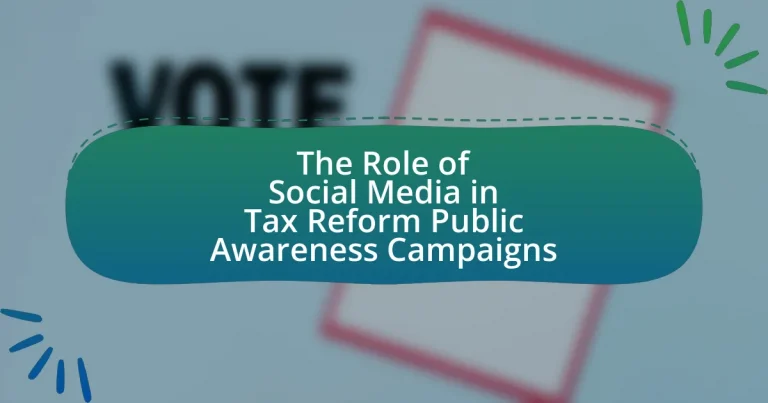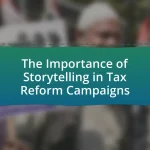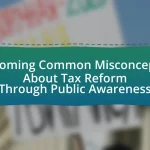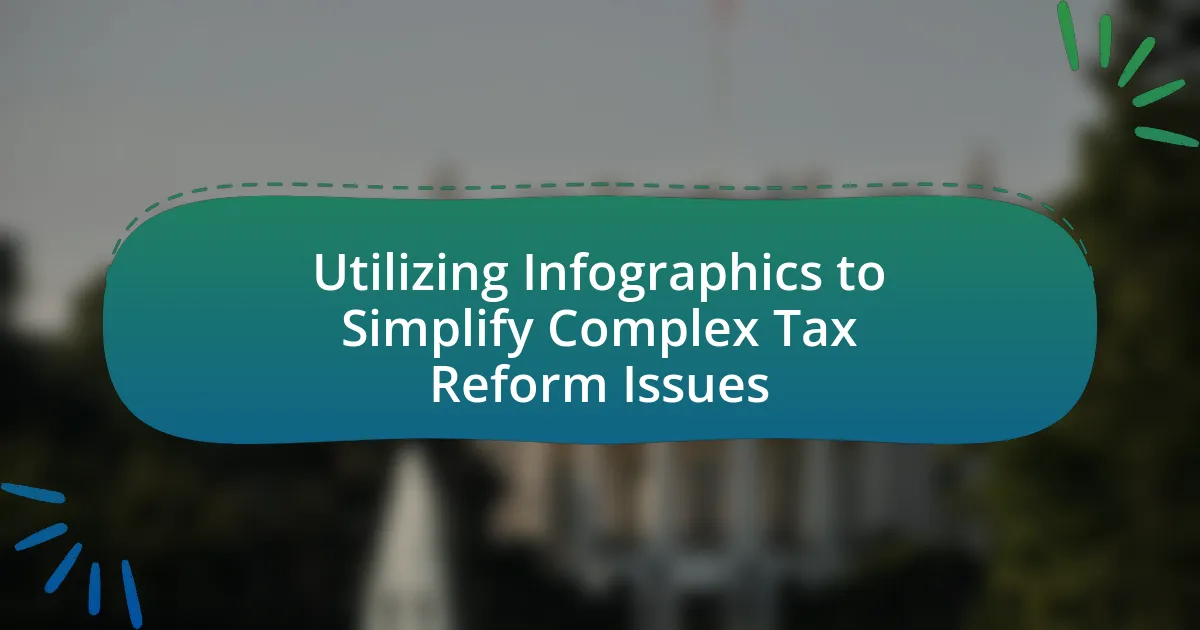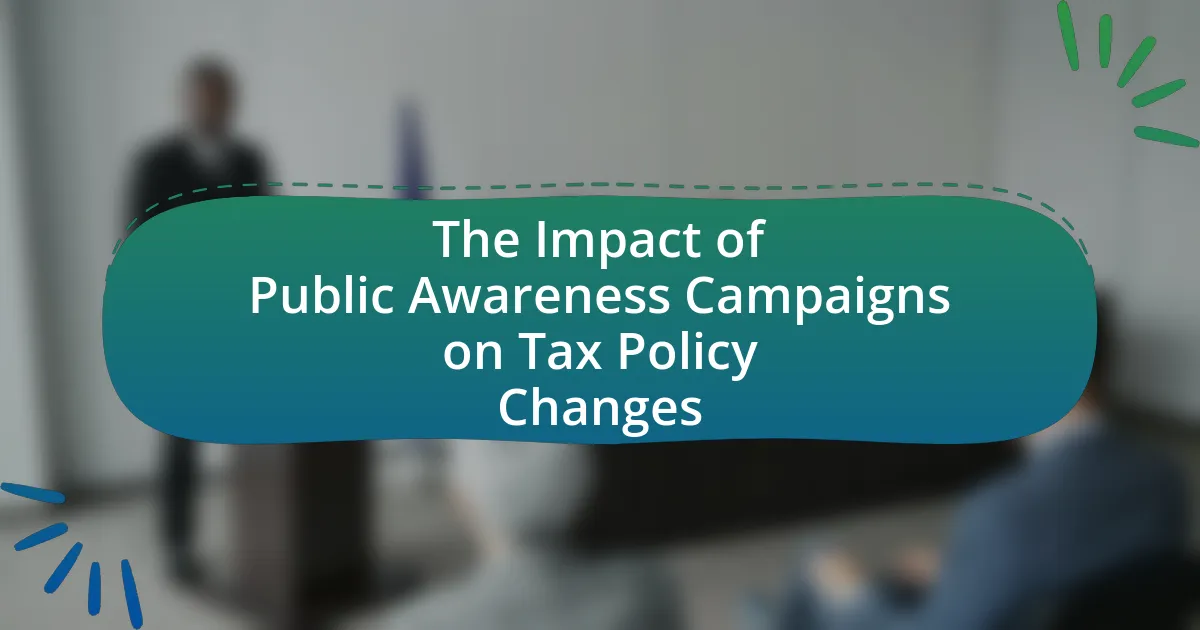The article examines the significant role of social media in enhancing public awareness campaigns related to tax reform. It highlights how platforms such as Facebook, Twitter, and Instagram facilitate the rapid dissemination of information, engage diverse audiences, and shape public perception of tax policies. Key aspects discussed include the influence of different demographics on engagement with tax reform content, the advantages of social media over traditional media, and the challenges campaigns face, such as misinformation and polarization. Additionally, the article outlines strategies for effective social media campaigns, the importance of analytics in measuring success, and future trends that may impact tax reform advocacy efforts.
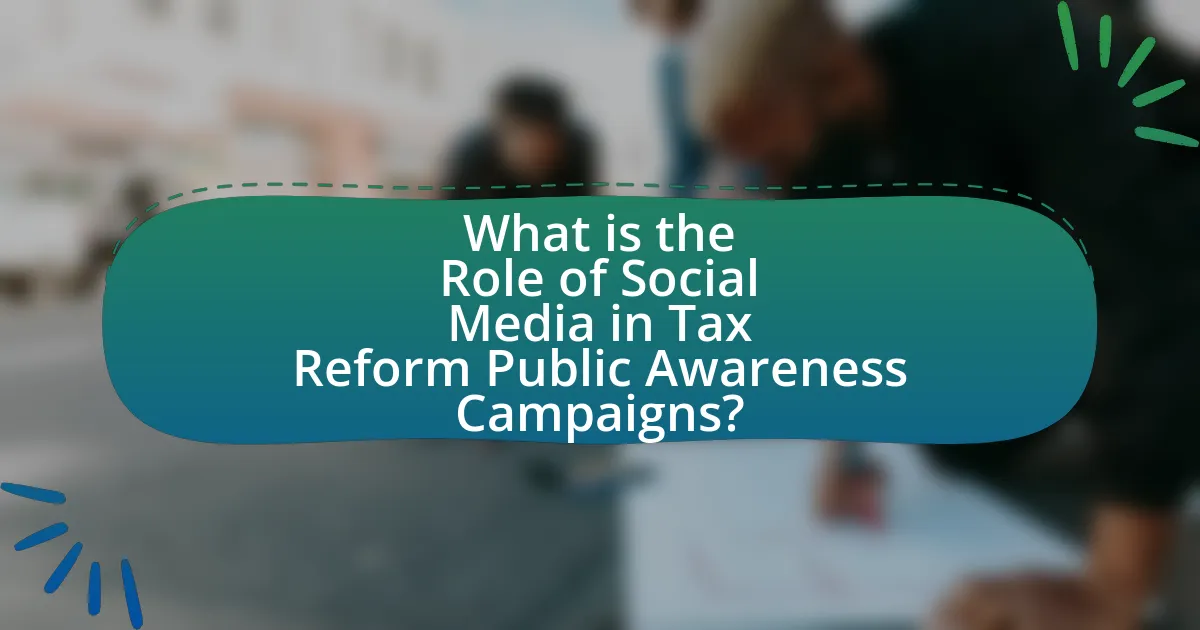
What is the Role of Social Media in Tax Reform Public Awareness Campaigns?
Social media plays a crucial role in tax reform public awareness campaigns by facilitating widespread dissemination of information and engaging diverse audiences. It allows organizations and advocates to share updates, educational content, and calls to action rapidly, reaching millions of users instantly. For instance, campaigns utilizing platforms like Twitter and Facebook can generate significant public discourse, as evidenced by the 2017 U.S. tax reform discussions, where social media amplified messages and mobilized grassroots support. Additionally, social media analytics provide insights into public sentiment, enabling campaigners to tailor their strategies effectively.
How does social media influence public perception of tax reform?
Social media significantly influences public perception of tax reform by shaping narratives and disseminating information rapidly. Platforms like Twitter and Facebook allow users to share opinions, news articles, and personal experiences related to tax policies, which can create a collective understanding or misunderstanding of the issues at hand. For instance, a study by the Pew Research Center found that 64% of Americans use social media to engage with news, indicating its role in informing public opinion. Additionally, social media can amplify voices of advocacy groups, leading to increased awareness and mobilization around specific tax reform proposals, thereby affecting how the public perceives their necessity and impact.
What are the key social media platforms used in tax reform campaigns?
The key social media platforms used in tax reform campaigns are Facebook, Twitter, Instagram, and LinkedIn. These platforms facilitate engagement and information dissemination, allowing organizations and advocates to reach a broad audience. For instance, Facebook’s targeted advertising capabilities enable campaigns to tailor messages to specific demographics, while Twitter’s real-time communication fosters immediate discussions around tax issues. Instagram’s visual content can effectively illustrate complex tax concepts, and LinkedIn serves as a professional network for sharing in-depth analyses and policy discussions. These platforms collectively enhance the visibility and impact of tax reform initiatives.
How do different demographics engage with tax reform content on social media?
Different demographics engage with tax reform content on social media in varied ways, influenced by factors such as age, education, and socioeconomic status. For instance, younger users, particularly those aged 18-29, tend to share and comment on tax reform posts more actively, often using platforms like Instagram and TikTok, which favor visual content. In contrast, older demographics, such as those aged 50 and above, are more likely to engage with tax reform discussions on Facebook, where they prefer detailed articles and community discussions.
Research indicates that individuals with higher education levels are more likely to engage critically with tax reform content, sharing articles and participating in discussions, while those with lower education levels may engage less frequently and rely on simplified summaries or infographics. Additionally, socioeconomic status plays a role, as individuals from lower-income backgrounds may engage with tax reform content that directly impacts their financial situation, often seeking information on benefits or relief programs.
These engagement patterns highlight the importance of tailoring tax reform messaging to resonate with specific demographic groups, ensuring that content is accessible and relevant to their unique perspectives and needs.
Why is social media important for tax reform public awareness?
Social media is important for tax reform public awareness because it facilitates rapid dissemination of information and engages a broad audience. Platforms like Twitter, Facebook, and Instagram allow organizations and advocates to share updates, educational content, and calls to action, reaching millions instantly. For instance, a study by the Pew Research Center found that 69% of adults in the U.S. use social media, making it a vital tool for engaging citizens in discussions about tax policies. Additionally, social media enables grassroots movements to mobilize support and influence policymakers by amplifying public sentiment and fostering community dialogue around tax reform issues.
What advantages does social media offer over traditional media in tax campaigns?
Social media offers greater engagement, cost-effectiveness, and real-time feedback compared to traditional media in tax campaigns. Engagement on social media platforms allows for interactive communication, enabling organizations to connect directly with the public, which is often more challenging with traditional media like print or television. For instance, a study by the Pew Research Center found that 69% of adults in the U.S. use social media, providing a vast audience for tax campaigns. Additionally, social media advertising is typically less expensive than traditional media, allowing for broader outreach within limited budgets. Real-time feedback on social media enables campaign organizers to adjust their strategies quickly based on audience reactions, a flexibility that traditional media lacks.
How does social media facilitate community engagement in tax reform discussions?
Social media facilitates community engagement in tax reform discussions by providing a platform for real-time communication and information sharing among diverse groups. This immediacy allows individuals to express opinions, ask questions, and share experiences related to tax policies, fostering a sense of community involvement. For instance, platforms like Twitter and Facebook enable users to participate in discussions, share relevant articles, and mobilize support for specific tax reform initiatives, which can lead to increased public awareness and advocacy. Research indicates that social media campaigns can significantly enhance public engagement; a study by the Pew Research Center found that 69% of adults in the U.S. use social media, making it a powerful tool for reaching a broad audience and encouraging dialogue on complex issues like tax reform.
What challenges do tax reform campaigns face on social media?
Tax reform campaigns face significant challenges on social media, including misinformation, polarization, and limited engagement. Misinformation can spread rapidly, leading to public confusion about tax policies and proposed reforms. Polarization occurs as social media platforms often amplify extreme viewpoints, making it difficult for campaigns to reach a consensus or moderate audience. Limited engagement is another challenge, as users may be disinterested in complex tax issues, resulting in low interaction rates with campaign content. These factors hinder the effectiveness of tax reform campaigns in raising awareness and fostering informed discussions among the public.
How can misinformation impact tax reform public awareness efforts?
Misinformation can significantly undermine tax reform public awareness efforts by creating confusion and distrust among the public. When inaccurate information circulates on social media, it can lead to misconceptions about the implications and benefits of proposed tax reforms, ultimately hindering informed public discourse. For instance, a study by the Pew Research Center found that 64% of Americans believe misinformation has a major impact on their understanding of political issues, including tax policies. This distortion of facts can result in public resistance to necessary reforms, as individuals may oppose changes based on false narratives rather than factual analysis.
What strategies can be employed to overcome social media challenges in tax campaigns?
To overcome social media challenges in tax campaigns, organizations can employ targeted messaging, audience segmentation, and engagement strategies. Targeted messaging ensures that the content resonates with specific demographics, addressing their unique concerns about tax reform. Audience segmentation allows campaigns to tailor their approaches based on factors such as age, income level, and geographic location, which can enhance relevance and effectiveness. Engagement strategies, such as interactive content and real-time responses to inquiries, foster community involvement and trust, which are crucial for successful campaigns. Research indicates that campaigns utilizing these strategies can increase public awareness and participation by up to 30%, demonstrating their effectiveness in navigating social media challenges.
How can social media campaigns be effectively designed for tax reform awareness?
Social media campaigns can be effectively designed for tax reform awareness by utilizing targeted messaging, engaging visuals, and interactive content to reach diverse audiences. Targeted messaging ensures that the information resonates with specific demographics, such as young professionals or small business owners, who may be directly affected by tax reforms. Engaging visuals, including infographics and videos, can simplify complex tax concepts, making them more accessible and shareable. Interactive content, such as polls or Q&A sessions, encourages audience participation and fosters a sense of community around the topic. Research indicates that campaigns incorporating these elements can increase engagement rates by up to 60%, demonstrating their effectiveness in raising awareness and prompting discussions about tax reform.
What are the best practices for creating engaging content related to tax reform?
To create engaging content related to tax reform, focus on clarity, relevance, and interactivity. Clear language helps demystify complex tax concepts, making them accessible to a broader audience. Relevant content should address current tax issues and reforms that directly impact individuals and businesses, ensuring that the information resonates with the audience’s experiences. Interactivity, such as polls or Q&A sessions, encourages audience participation and fosters a sense of community.
Research indicates that content that simplifies tax reform discussions and incorporates real-life examples can significantly enhance audience engagement. For instance, a study by the Pew Research Center found that 64% of social media users prefer content that includes personal stories or relatable scenarios. This approach not only informs but also connects emotionally with the audience, making the content more memorable and impactful.
How can analytics be used to measure the success of social media tax campaigns?
Analytics can be used to measure the success of social media tax campaigns by tracking key performance indicators (KPIs) such as engagement rates, reach, conversion rates, and sentiment analysis. These metrics provide insights into how well the campaign resonates with the target audience and its effectiveness in driving desired actions, such as sharing information or participating in discussions about tax reform. For instance, a study by Hootsuite found that campaigns with higher engagement rates typically lead to increased awareness and understanding of tax issues among the public, demonstrating a direct correlation between social media activity and public sentiment.
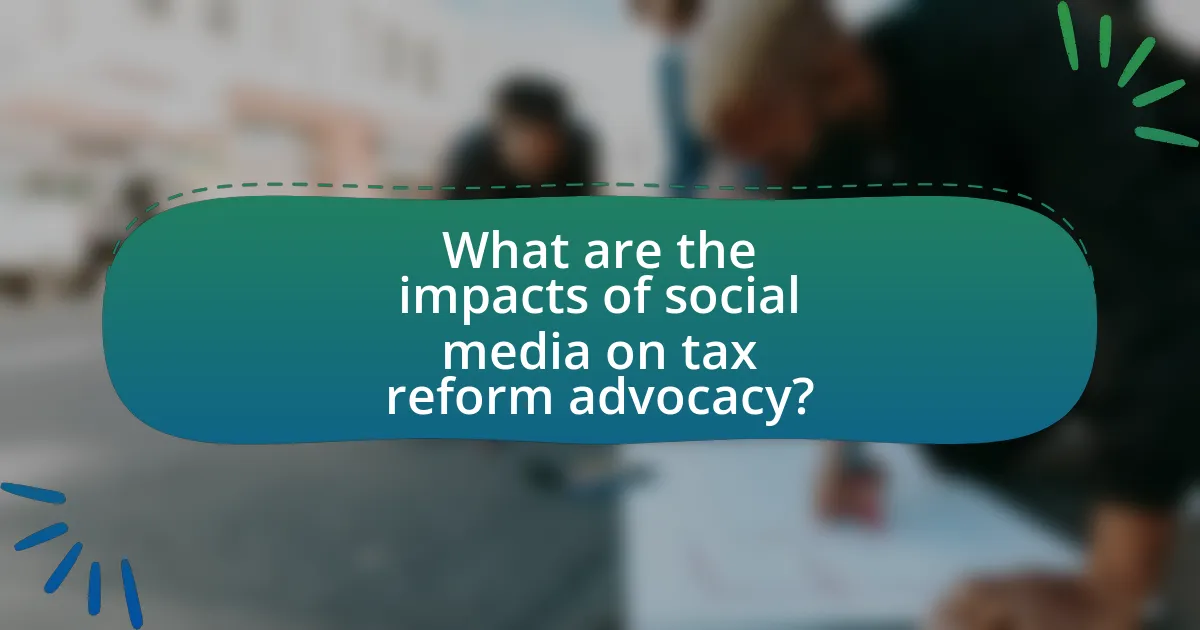
What are the impacts of social media on tax reform advocacy?
Social media significantly enhances tax reform advocacy by facilitating rapid information dissemination and mobilizing public engagement. Platforms like Twitter and Facebook allow advocates to share updates, research, and calls to action instantly, reaching a broad audience. For instance, a study by the Pew Research Center found that 69% of adults in the U.S. use social media, providing a vast network for advocacy efforts. Additionally, social media enables grassroots movements to organize campaigns effectively, as seen in various tax reform initiatives that gained traction through viral posts and hashtags. This increased visibility can influence policymakers by demonstrating public support or opposition, ultimately impacting legislative outcomes.
How does social media mobilize grassroots support for tax reform?
Social media mobilizes grassroots support for tax reform by facilitating rapid information dissemination and community engagement. Platforms like Facebook and Twitter allow individuals and organizations to share personal stories, data, and calls to action, which can resonate with a wide audience. For instance, campaigns such as the “Tax Fairness” movement have utilized hashtags to unify voices and amplify messages, leading to increased public discourse and participation in advocacy efforts. Research indicates that social media can enhance civic engagement, with a study by the Pew Research Center showing that 69% of adults in the U.S. use social media, making it a powerful tool for organizing and rallying support around tax reform initiatives.
What role do influencers play in shaping tax reform narratives on social media?
Influencers play a significant role in shaping tax reform narratives on social media by leveraging their platforms to disseminate information, mobilize public opinion, and engage audiences in discussions about tax policies. Their ability to reach large, diverse audiences allows them to frame tax reform issues in relatable terms, making complex topics more accessible. For instance, influencers often share personal stories or simplified explanations that resonate with their followers, which can lead to increased awareness and understanding of tax reform initiatives. Research indicates that social media influencers can significantly impact public perceptions and attitudes, as seen in campaigns where influencers have successfully advocated for specific tax reforms, thereby influencing legislative discussions and public sentiment.
How can user-generated content enhance tax reform campaigns?
User-generated content can enhance tax reform campaigns by fostering community engagement and providing authentic perspectives on tax issues. This type of content allows individuals to share personal stories and experiences related to taxation, which can humanize the complexities of tax reform and make the topic more relatable. For instance, campaigns that incorporate testimonials or case studies from citizens can illustrate the real-world impact of tax policies, thereby increasing public interest and understanding. Research indicates that campaigns utilizing user-generated content often see higher levels of interaction and sharing on social media platforms, which can amplify the reach and effectiveness of tax reform messages.
What are the implications of social media engagement for policymakers?
Social media engagement significantly influences policymakers by shaping public opinion and facilitating direct communication with constituents. This engagement allows policymakers to gauge public sentiment on tax reform issues, enabling them to tailor their policies and messaging accordingly. For instance, a study by the Pew Research Center found that 69% of adults in the U.S. use social media, highlighting its potential as a platform for policymakers to disseminate information and gather feedback. Additionally, social media can amplify grassroots movements, which can pressure policymakers to consider public demands in their decision-making processes. This dynamic interaction underscores the necessity for policymakers to actively engage on social media to remain responsive and accountable to the electorate.
How can policymakers leverage social media feedback in tax reform initiatives?
Policymakers can leverage social media feedback in tax reform initiatives by actively monitoring and analyzing public sentiment and opinions expressed on these platforms. This approach allows them to identify key concerns, preferences, and misconceptions among constituents, which can inform the design and communication of tax policies. For instance, a study by the Pew Research Center found that 69% of adults in the U.S. use social media, making it a valuable tool for gauging public reaction and fostering engagement. By integrating this feedback into their strategies, policymakers can enhance transparency, build trust, and ensure that tax reforms align with the needs and expectations of the public.
What are the risks of relying on social media for public opinion on tax reform?
Relying on social media for public opinion on tax reform poses significant risks, including misinformation, echo chambers, and lack of representativeness. Misinformation can spread rapidly on social media platforms, leading to public confusion about tax policies; for instance, a study by the Pew Research Center found that 64% of Americans believe that false information causes confusion about government policies. Echo chambers occur when users are exposed primarily to viewpoints that reinforce their own, limiting diverse perspectives and critical discussions about tax reform. Additionally, social media demographics may not accurately reflect the broader population, resulting in skewed opinions that do not represent the views of all stakeholders affected by tax policies.

How can organizations optimize their social media strategies for tax reform campaigns?
Organizations can optimize their social media strategies for tax reform campaigns by leveraging targeted messaging, engaging content, and data analytics. Targeted messaging ensures that the campaign reaches specific demographics affected by tax reforms, increasing relevance and engagement. Engaging content, such as infographics and videos, can simplify complex tax issues, making them more accessible to the public. Data analytics allows organizations to track engagement metrics and adjust strategies in real-time, ensuring that the campaign remains effective and responsive to audience feedback. For instance, a study by the Pew Research Center found that 69% of adults in the U.S. use social media, highlighting the platform’s potential reach for tax reform messaging.
What tools and resources are available for managing social media tax campaigns?
Tools and resources available for managing social media tax campaigns include social media management platforms, analytics tools, and content creation resources. Platforms like Hootsuite and Buffer allow users to schedule posts, monitor engagement, and manage multiple accounts efficiently. Analytics tools such as Google Analytics and Sprout Social provide insights into audience behavior and campaign performance, enabling data-driven decisions. Additionally, resources like Canva and Adobe Spark assist in creating visually appealing content tailored for social media, enhancing engagement and outreach. These tools collectively facilitate effective management and optimization of tax campaigns on social media.
How can organizations create a content calendar for tax reform awareness?
Organizations can create a content calendar for tax reform awareness by identifying key dates related to tax policy changes and aligning content themes with these dates. This involves researching significant tax reform milestones, such as legislative deadlines or public comment periods, and scheduling posts that educate the audience on these topics. For instance, the IRS typically releases tax updates in January, making it an ideal time to share information about new tax laws. Additionally, organizations should incorporate various content formats, such as infographics, videos, and articles, to engage different audience segments effectively. By analyzing engagement metrics from previous campaigns, organizations can refine their content strategy to maximize reach and impact.
What metrics should be tracked to evaluate the effectiveness of social media strategies?
To evaluate the effectiveness of social media strategies, key metrics to track include engagement rate, reach, impressions, conversion rate, and follower growth. Engagement rate measures the level of interaction (likes, shares, comments) relative to total followers, indicating how well content resonates with the audience. Reach quantifies the number of unique users who see the content, while impressions count the total views, providing insight into visibility. Conversion rate tracks the percentage of users who take a desired action, such as signing a petition or visiting a website, reflecting the strategy’s impact on behavior. Follower growth indicates the increase in audience size over time, showcasing the campaign’s ability to attract new supporters. These metrics collectively provide a comprehensive view of social media strategy effectiveness in raising awareness for tax reform initiatives.
What are the future trends in social media and tax reform awareness campaigns?
Future trends in social media and tax reform awareness campaigns include increased use of targeted advertising, interactive content, and data analytics to engage specific demographics effectively. Social media platforms are evolving to offer advanced targeting options, allowing campaigns to reach audiences based on their interests, behaviors, and geographic locations. For instance, a study by the Pew Research Center indicates that 69% of adults in the U.S. use social media, making it a crucial channel for disseminating information about tax reforms. Additionally, interactive content such as polls, quizzes, and live Q&A sessions can enhance user engagement, as evidenced by campaigns that have successfully utilized these formats to boost participation rates. Furthermore, the integration of data analytics enables campaign organizers to measure the effectiveness of their outreach efforts in real-time, allowing for adjustments that can improve overall impact.
How might emerging technologies influence social media strategies for tax reform?
Emerging technologies significantly influence social media strategies for tax reform by enabling targeted communication and real-time engagement with diverse audiences. These technologies, such as artificial intelligence and data analytics, allow organizations to analyze user behavior and preferences, tailoring content to resonate with specific demographics. For instance, the use of machine learning algorithms can optimize ad placements and messaging, increasing the likelihood of reaching individuals most affected by tax policies. Additionally, platforms like social media can leverage augmented reality and interactive content to enhance user engagement, making complex tax reform issues more accessible and understandable. This approach is supported by studies showing that personalized content increases user interaction rates, thereby amplifying the effectiveness of public awareness campaigns.
What role will data privacy concerns play in future tax reform campaigns on social media?
Data privacy concerns will significantly influence future tax reform campaigns on social media by shaping public trust and engagement. As individuals become increasingly aware of how their personal data is collected and used, campaigns that prioritize transparency and data protection are likely to resonate more effectively with audiences. Research indicates that 79% of consumers express concern over how their data is used by companies, which suggests that tax reform campaigns that address these concerns directly may foster greater participation and support. Therefore, integrating data privacy considerations into campaign strategies will be essential for enhancing credibility and mobilizing public action in tax reform discussions.
What practical tips can organizations implement for successful social media tax campaigns?
Organizations can implement targeted audience segmentation for successful social media tax campaigns. By identifying specific demographics, interests, and behaviors, organizations can tailor their messaging to resonate with different groups, increasing engagement and effectiveness. For instance, a study by the Pew Research Center found that 69% of adults in the U.S. use social media, highlighting the platform’s potential reach. Additionally, using clear and concise messaging that simplifies complex tax concepts can enhance understanding and encourage participation. Engaging visuals and infographics can further aid in conveying information effectively, as research indicates that visual content is processed 60,000 times faster than text. Regularly analyzing engagement metrics allows organizations to refine their strategies based on what resonates most with their audience, ensuring continuous improvement in campaign effectiveness.
